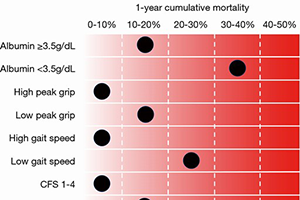Impact of frailty markers on outcomes after transcatheter aortic valve replacement: insights from a Japanese multicenter registry
Abstract
There are no standardized criteria for measuring patients’ frailty. We examined prognosis based on four frailty markers [serum albumin level, grip strength, gait speed, and clinical frailty scale (CFS)] in patients who underwent transcatheter aortic valve replacement (TAVR) between October 2013 and April 2016 and were recorded in the Optimized CathEter vAlvular iNtervention (OCEAN) Japanese multicenter registry. Serum albumin level was assessed by dividing patients into two groups: hypoalbuminemia or non-hypoalbuminemia according to their serum albumin level. Clinical outcomes including all-cause, cardiovascular and non-cardiovascular mortality rates after TAVR were compared. During the follow-up period cumulative all-cause, cardiovascular and non-cardiovascular mortality rates were significantly higher in the hypoalbuminemia group than in the non-hypoalbuminemia group. This result remained unchanged even after a propensity-matched model was used in terms of cumulative all-cause and non-cardiovascular mortality; however, differences in cardiovascular mortality rates were attenuated. To consider the impact of grip strength patients were divided into a low or high peak grip strength group based on classification and regression tree (CART) survival analysis. The clinical outcomes for each sex were compared between the two groups. In both sexes the cumulative 1-year mortality rates were significantly different between the two groups. To investigate gait speed patients were classified into two gait speed groups (low or high gait speed group) based on CART survival analysis. Clinical outcomes were compared between the two groups. The cumulative 1-year mortality rate was significantly different between the two gait speed groups. The effect of CFS on prognosis after TAVR was assessed. Patients were categorized into five groups based on the following CFS scores: CFS1-3, CFS4, CFS5, CFS6, and CFS ≥7. We evaluated the relationship between the CFS score and other indicators of frailty markers. We also assessed the mid-term mortality among the five groups. The CFS score had a significant correlation with other frailty markers. The cumulative 1-year mortality increased with an increasing CFS score. In the Cox regression multivariate analysis, the CFS score was an independent predictive factor of an increased late cumulative mortality risk. In conclusion, the results suggest that serum albumin level, grip strength, gait speed, and CFS score are all useful indicators when considering the optimal indications and risk stratification for TAVR.
Cover






